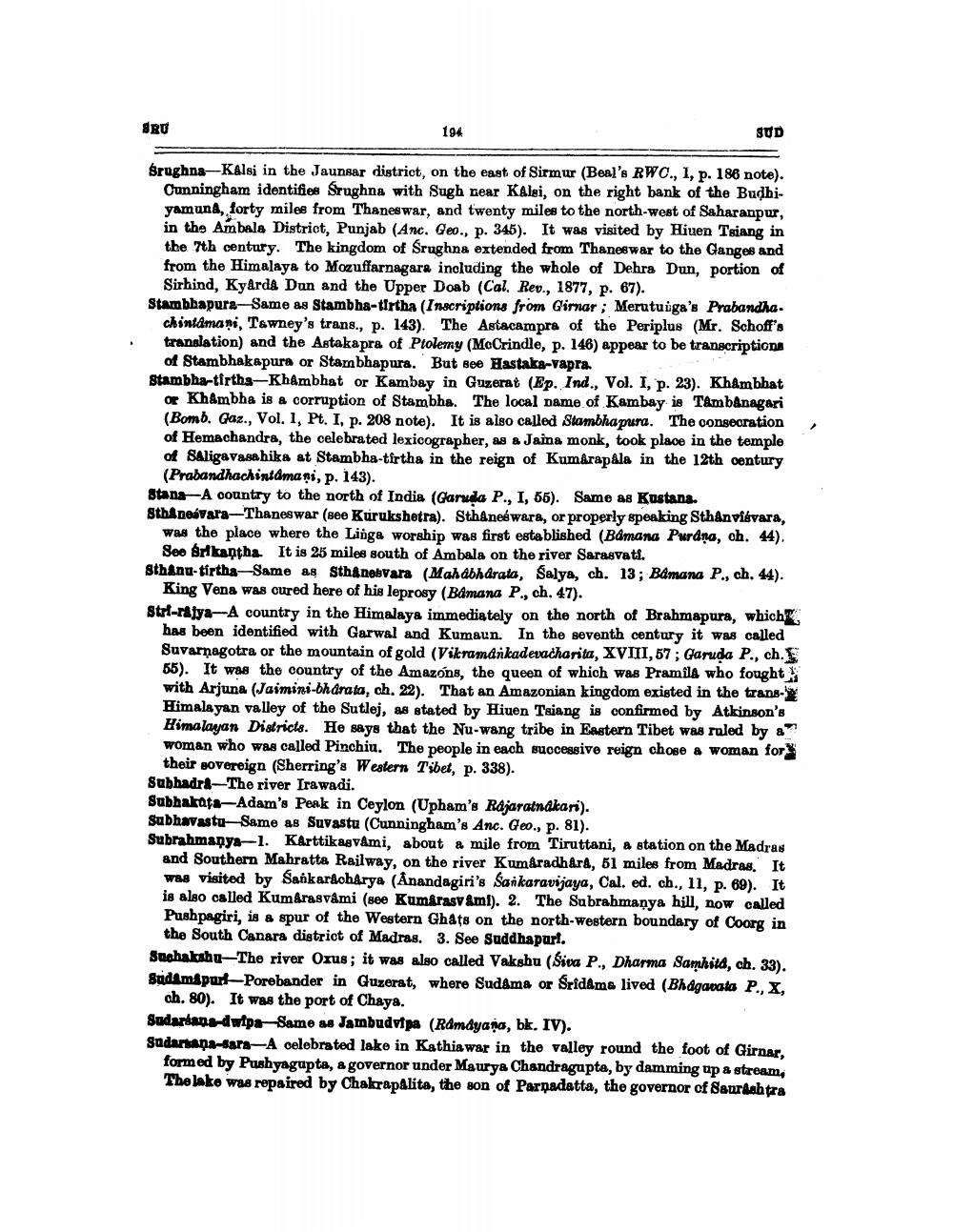________________
BRU
194
SUD
Srughna-Kalsi in the Jaunsar district, on the east of Sirmur (Beal's RWC., 1, p. 186 note). Cunningham identifies Śrughna with Sugh near Kalsi, on the right bank of the Budhiyamuna, forty miles from Thaneswar, and twenty miles to the north-west of Saharanpur, in the Ambala District, Punjab (Anc. Geo., p. 345). It was visited by Hiuen Tsiang in the 7th century. The kingdom of Srughna extended from Thaneswar to the Ganges and from the Himalaya to Mozuffarnagara including the whole of Dehra Dun, portion of Sirhind, Kyårda Dun and the Upper Doab (Cal. Rev., 1877, p. 67). Stambhapura-Same as Stambha-tirtha (Inscriptions from Girnar; Merutuiga's Prabandha. chintamani, Tawney's trans., p. 143). The Astacampra of the Periplus (Mr. Schoff's translation) and the Astakapra of Ptolemy (McCrindle, p. 146) appear to be transcriptions of Stambhakapura or Stambhapura. But see Hastaka-vapra. Stambha-tirtha-Khambhat or Kambay in Guzerat (Ep. Ind., Vol. I, p. 23). Khambhat or Khambha is a corruption of Stambha. The local name of Kambay is Tambanagari (Bomb. Gaz., Vol. 1, Pt. I, p. 208 note). It is also called Stambhapura. The consecration of Hemachandra, the celebrated lexicographer, as a Jaina monk, took place in the temple of Saligavasa hika at Stambha-tirtha in the reign of Kumarapala in the 12th century (Prabandhachintamani, p. 143).
Stana-A country to the north of India (Garuda P., I, 55). Same as Kustana. Sthanesvara-Thaneswar (see Kurukshetra). Sthâneéwara, or properly speaking Sthanviévara, was the place where the Linga worship was first established (Bamana Purana, ch. 44). See Brikantha. It is 25 miles south of Ambala on the river Sarasvati. Sthânu-tirtha-Same as Sthanesvara (Mahabharata, Salya, ch. 13; Bamana P., ch. 44).
King Vena was cured here of his leprosy (Bamana P., ch. 47).
Stri-rajya-A country in the Himalaya immediately on the north of Brahmapura, which has been identified with Garwal and Kumaun. In the seventh century it was called Suvarnagotra or the mountain of gold (Vikramankadevacharita, XVIII, 57; Garuda P., ch. 55). It was the country of the Amazons, the queen of which was Pramila who fought with Arjuna (Jaimini-bharata, ch. 22). That an Amazonian kingdom existed in the transHimalayan valley of the Sutlej, as stated by Hiuen Tsiang is confirmed by Atkinson's Himalayan Districts. He says that the Nu-wang tribe in Eastern Tibet was ruled by a woman who was called Pinchiu. The people in each successive reign chose a woman for their sovereign (Sherring's Western Tibet, p. 338).
Subhadra-The river Irawadi.
Subhakata-Adam's Peak in Ceylon (Upham's Rajaratnakari). Subhavastu Same as Suvastu (Cunningham's Anc. Geo., p. 81).
Subrahmanya-1. Karttikasvami, about a mile from Tiruttani, a station on the Madras and Southern Mahratta Railway, on the river Kumaradhara, 51 miles from Madras. It was visited by Sankaracharya (Anandagiri's Sankaravijaya, Cal. ed. ch., 11, p. 69). It is also called Kumârasvami (see Kumarasvami). 2. The Subrahmanya hill, now called Pushpagiri, is a spur of the Western Ghats on the north-western boundary of Coorg in the South Canara district of Madras. 3. See Suddhapuri.
Suchakshu-The river Oxus; it was also called Vakshu (Siva P., Dharma Samhita, ch. 33). Sudamapuri-Porebander in Guzerat, where Sudama or Sridams lived (Bhagavata P., X,
ch. 80). It was the port of Chaya.
Sudarsana-dwipa-Same as Jambudvipa (Ramayana, bk. IV).
Sudarsana-sara-A celebrated lake in Kathiawar in the valley round the foot of Girnar, formed by Pushyagupta, a governor under Maurya Chandragupta, by damming up a stream, The lake was repaired by Chakrapalita, the son of Parnadatta, the governor of Saurashtra




